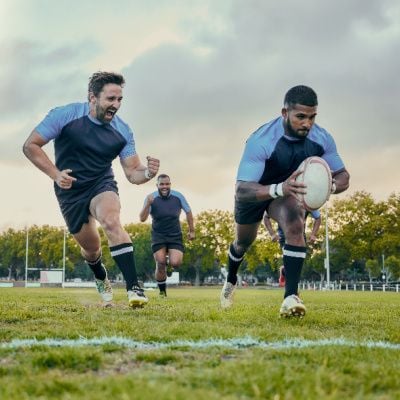 Rugby, a high-impact sport celebrated for its intensity and camaraderie, subjects players to many challenges, especially concerning foot and ankle health. In this in-depth exploration, we unravel the common rugby-related injuries affecting the lower extremities, shedding light on prevention, management, and the vital role of specialized care in keeping rugby enthusiasts on their feet.
Rugby, a high-impact sport celebrated for its intensity and camaraderie, subjects players to many challenges, especially concerning foot and ankle health. In this in-depth exploration, we unravel the common rugby-related injuries affecting the lower extremities, shedding light on prevention, management, and the vital role of specialized care in keeping rugby enthusiasts on their feet.
The Dynamic Nature of Rugby and Its Impact on Feet and Ankles
Rugby is a testament to physical prowess, demanding agility, strength, and resilience. However, the elements that make the sport exhilarating also contribute to players' susceptibility to foot and ankle injuries.
-
Sprains and Strains:
- Swift changes in direction, sudden stops, and high-impact collisions expose players to the risk of sprained ligaments and strained muscles in the foot and ankle. The lateral movements intrinsic to the game can lead to overstretching and tearing of these crucial structures.
-
Fractures and Dislocations:
- The robust physicality of rugby increases the likelihood of fractures and dislocations. Direct trauma, often occurring during tackles or scrums, may result in fractures in the bones of the foot and ankle, while dislocations can occur due to the forceful impact of tackles.
Specific Rugby-Related Injuries to the Foot and Ankle
-
Lisfranc Injury:
- Named after a 19th-century French surgeon, a Lisfranc injury involves the dislocation or fracture of the midfoot. The unique biomechanics of rugby, with players frequently pushing off from the ground and pivoting, make the midfoot vulnerable to such injuries.
-
Turf Toe:
- Turf toe, characterized by a sprain to the ligaments surrounding the big toe joint, is prevalent in rugby. The constant pressure on the forefoot during scrums and the sudden acceleration required during sprints contribute to this injury.
-
Achilles Tendon Rupture:
- The explosive movements and sudden changes in pace in rugby can predispose players to Achilles tendon ruptures. This injury, involving the tearing of the Achilles tendon, often occurs during rapid acceleration or abrupt stops.
Preventive Measures and Player Awareness
-
Proper Conditioning and Warm-Up:
- Rigorous conditioning programs that focus on strengthening the muscles and ligaments of the foot and ankle are paramount. Additionally, a thorough warm-up routine before matches and training sessions helps prepare the lower extremities for the demands of the game.
-
Footwear Selection:
- Choosing appropriate footwear tailored to the player's position and foot type plays a crucial role in injury prevention. Cleats with adequate ankle support and stud configurations suited to the playing surface contribute to foot and ankle stability.
The Role of Specialized Care and Rehabilitation
-
Immediate Medical Attention:
- Prompt recognition and assessment of foot and ankle injuries are vital. Seeking immediate medical attention ensures accurate diagnosis and facilitates timely intervention, preventing the exacerbation of injuries.
-
Rehabilitation Programs:
- Tailored rehabilitation programs, guided by sports medicine professionals, form the cornerstone of recovery. These programs focus on restoring strength, flexibility, and proprioception, essential for a safe return to the rugby field.
The Future of Foot and Ankle Health in Rugby
As rugby continues to captivate athletes and fans alike, prioritizing foot and ankle health becomes an integral aspect of the game's longevity. With advancements in sports medicine and a growing emphasis on injury prevention strategies, the future holds promise for minimizing the impact of foot and ankle injuries in rugby.
Conclusion
With its fast-paced and physically demanding nature, rugby brings both exhilaration and risks. Understanding the intricacies of foot and ankle injuries in the context of this sport allows players, coaches, and medical professionals to collaborate in fostering a culture of preventive measures and swift, effective management. As rugby enthusiasts lace up their boots and take to the field, a collective commitment to foot and ankle health ensures that the game remains a thrilling spectacle without compromising the well-being of its players.
Disclaimer:
The information on this website is provided for educational and information purposes only and is not medical advice. Always consult with a licensed medical provider and follow their recommendations regardless of what you read on this website. If you think you are having a medical emergency, dial 911 or go to the nearest emergency room. Links to other third-party websites are provided for your convenience only. If you decide to access any of the third-party websites, you do so entirely at your own risk and subject to the terms of use for those websites. Neither Viera Podiatry, nor any contributor to this website, makes any representation, express or implied, regarding the information provided on this website or any information you may access on a third-party website using a link. Use of this website does not establish a doctor-patient relationship. If you would like to request an appointment with a health care provider, please call our office at (321) 253-4973.
